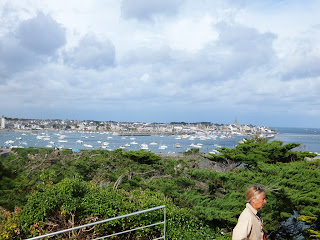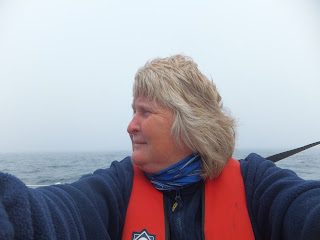The sail is a large triangle of cloth about 50 ft from top to bottom and probably 20 ft along the bottom edge. The plan is to get the boat running down wind with the main sail out wide and to hoist the big cruising chute behind the main, shadowed from the following wind, to prevent it from powering up before we had it all properly hoisted and set up. Once hoisted you turn back onto your course, the sail fills and away you go. THAT IS THE PLAN but all plans are made to be rendered useless by what uncle Norman used to call THE BUGGERATION FACTOR!!
On this occasion Chris was on the helm and I was on the foredeck with the sail in its bag. Emerging from the top of the bag are the three corners of the sail marked Head, Tack and Clew. The head is top corner, the tack is the one that is tied down to the bow of the boat and the clew is the one that has the sheet ropes tied to it. I connected the ropes, told Chris to set the autopilot to sail on a run and she hoisted the sail by pulling un the halyard.
WELL, I don't know what happened but the sail came out of the bag twisted in a knot, just at that moment the wind shifted so that the chute was no longer shadowed by the main, the sail filled and got itself tangled around the baby-stay and we were in a bit of bother. I'm sure that at one point I was wrapped in sailcloth like a mummy and the only features visible was my beer belly and glasses. Chris quickly got the boat back on the run but I couldn't get the sail un-knotted. No matter how much I swore at it it refused to obey and just seemed to have a mind of it's own. Eventually, after much faffing and cursing I got the sail down and we tried it all over again. The same thing happened so we gave up and decided it was all too difficult with the wind shifting as it was so we motored the rest of the way.
Roscoff
Roscoff is an old town with a ferry port, Brittany Ferries run their service from Plymouth but when you look at the coastline it is surprising that you can navigate a ship in there as the rocks and shallows all around look horrendous. Up till last year there was no marina so your only option as a small, visiting boat was to anchor but they have now built a brand new marina. The major parts of it are finished but the facilities are not. Showers and toilets are currently in portacabins and the capitainery is likewise in temporary accommodation.
It is quite a game going to the loo. When you open the door and walk into a cubicle and shut the door behind you there is so little room that you can't bend down to retrieve your shorts from around your ankles.
Likewise in the showers there is no seat or shelf to put your wash-bag on, there are a couple of hooks for clothes and the floor is a cm deep in water because there are no shower doors and the water sprays everywhere. When we arrived it was the day before the start of a big yacht race and there were about 100 extra people (visiting race crews) to accommodate so to get a shower took forever and when you did get in there the water was cold.
However Roscoff is a wonderful place dating back a long time. There are wonderful old stone buildings and streets all cobbled with granite. There are two harbours, one is the new marina mentioned earlier and the other is a drying harbour dating back to the year dot.
Roscoff old harbour
Old harbour
vantage point for seeing the racing
Yacht Race
More to come later re-Roscoff ..................................





































